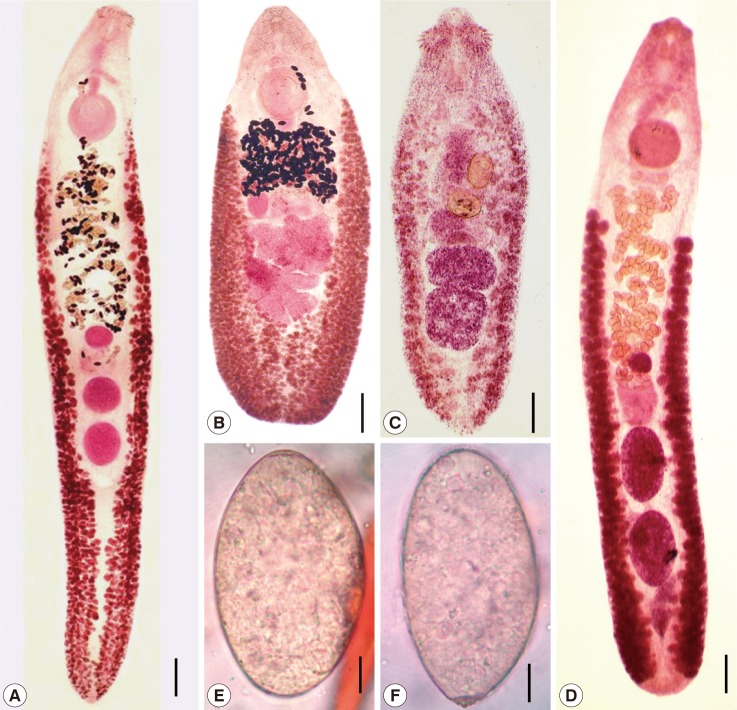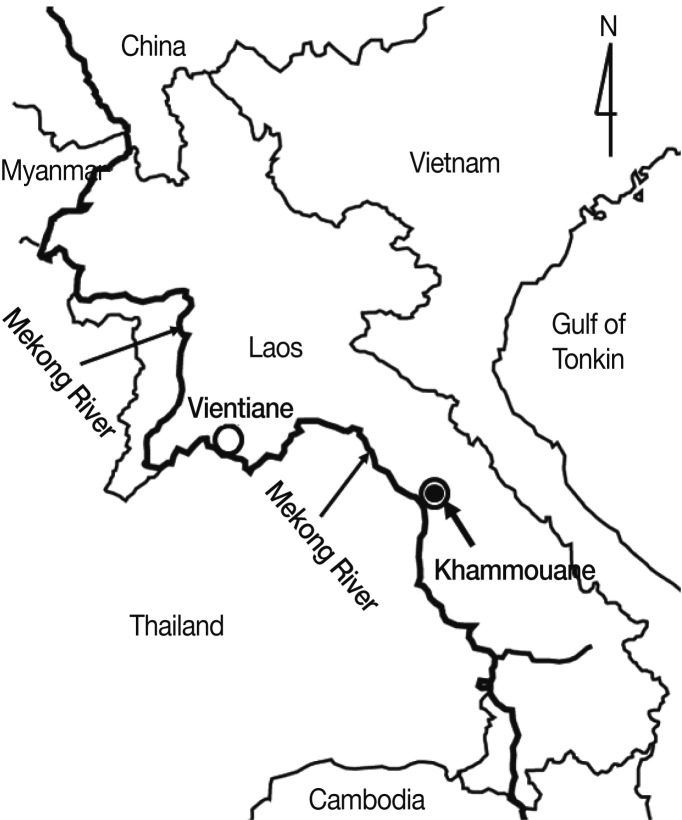Echinostome Flukes Receovered from Humans in Khammouane Province, Lao PDR
Article information
Abstract
Echinostome eggs were detected in 22 (1.1%) of 2,074 people residing in riparian villages along the Mekong River in Khammouane Province, Lao PDR. In order to recover the adult flukes, 9 persons were treated with praziquantel and purged with magnesium salts. A total of 55 echinostome specimens (4 species) were recovered from the 9 persons. Echinostoma revolutum (8 specimens) was recovered from 3 persons, Artyfechinostomum malayanum (8 specimens) was from 2 persons, Echinochasmus japonicus (33 specimens) was from 7 persons, and Euparyphium sp. (6 specimens) was from 1 person. In Lao PDR, only human infections with E. japonicus were previously known. Therefore, the present study describes human infections with E. revolutum, A. malayanum, and Euparyphium sp. for the first time in Lao PDR. These results indicate that the surveyed villages of Khammouane Province, Lao PDR are low-grade endemic foci of echinostomiasis.
Echinostomes (=family Echinostomatidae) are intestinal trematodes of humans and animals, and can cause severe epigastric or abdominal pain accompanied by diarrhea, easy fatigue, and malnutrition in humans [1]. Heavy worm loads may lead to mortality due to intestinal perforation or marked malnutrition and anemia, as reported in Artyfechinostomum malayanum [1]. A total of 20 species which belong to 8 genera (Echinostoma, Echinochasmus, Acanthoparyphium, Artyfechinostomum, Episthmium, Himasthla, Hypoderaeum, and Isthmiophora) are known to infect humans worldwide [1].
In the Lao People's Democratic Republic (Lao PDR), infections with soil-transmitted nematodes, including hookworms, and food-borne trematodes, including Opisthorchis viverrini, Haplorchis spp., and lecithodendriids, are common [2-5]. A blood fluke species, Schistosoma mekongi, is endemic in the Khong Islands, Champassak Province [6]. With regard to echinostomes, eggs were at times detected in fecal examinations of Laotians [3]. However, identification of adult flukes was not performed. The Korea Association of Health Promotion, Korea, and the Department of Hygiene and Prevention, Ministry of Health, Lao PDR (MOH, Laos) (2000-2004) and the Korea Foundation for International Healthcare and MOH, Laos (2007-2011), conducted collaborative projects to control intestinal helminthiases in Lao PDR. During the study period, we performed stool surveys in 3 villages of Khammouane Province and found several echinostome egg-positive cases. Adult echinostomes were recovered after treatment with praziquantel and purging with magnesium salts. They consisted of 4 echinostome species, namely Echinostoma revolutum, Artyfechinostomum malayanum, Echinochasmus japonicus, and Euparyphium sp. Here, we report echinostomiasis as one of the endemic trematode infections among the residents of Khammouane Province, Lao PDR.
The surveyed areas were riparian (tributaries of the Mekong River) villages (Nong Bone, Mahaxay, Phova, Natou, Som, Thongmang, and Phonmen) in Khammouane Province, Lao PDR (Fig. 1). A total of 2,074 fecal samples, one sample from each person, were collected. Samples were transported to the Malaria Station in Khammouane and examined using the Kato-Katz thick smear technique. Echinostome eggs were detected in a total of 22 people (1.1%). Nine of them, including 6 men (aged 24, 25, 32, 34, 42, and 43 years) and 3 women (aged 30, 40, and 42 years) residing in the Nong Bone, Phova, or Natou village, were subjected to adult worm recovery after chemotherapy and purgation. Some results of other parasites surveyed during 2000-2004 were published elsewhere [4].
Worm recovery was performed as described previously [3-5]. Briefly, after obtaining informed consent, the egg-positive people were given a single oral dose of 30-40 mg/kg praziquantel (Shinpoong Pharm. Co., Seoul, Korea) mixed with 10-15 mg/kg pyrantel pamoate (Hangzhou Minsheng Pharm. Group, Hangzhou, China) and purged with 20-30 g MgSO4. Worms were collected from the diarrheic stools and washed several times in water. They were fixed in 10% formalin under cover slip pressure, stained with acetocarmine, and morphologically examined. Fecal examination and anthelmintic treatment were officially approved by the Ministry of Health, Lao PDR, under the agreement of the Korea-Laos International Collaboration on Intestinal Parasite Control in Lao PDR (2000-2004 and 2007-2011).
A total of 55 echinostome specimens were recovered from 9 patients (Table 1; Fig. 2A-F). They consisted of 8 specimens (including 2 immature worms) of E. revolutum, 8 of A. malayanum, 33 of E. japonicus, and 6 of Euparyphium sp. (Table 1). E. revolutum were leaf-like, elongated (Fig. 2A), and averaged 11.1 (10.0-12.0) mm in length and 2.1 (1.8-2.4) mm in width (n= 6). They had 37 collar spines, arranged in a single row, including 5 end group spines on each side, and 2 globular or slightly lobulated testes in the post-equatorial region. The eggs in the feces were large and oval, with a characteristic operculum and an abopercular wrinkle or a knob (Fig. 2E, F). The uterine eggs measured 104 (98-115) µm by 63 (60-65) µm (n=10). A. malayanum worms had a slightly elongated or plump body with a rounded posterior end (Fig. 2B), and were 6.9-9.3 mm long and 2.8-3.2 mm wide (n=5). They had 43 collar spines, arranged in 2 alternating rows, including 5 end group spines on each side, and 2 deeply branched testes. The uterine eggs were 124 (120-128) µm by 86 (82-90) µm (n=10). E. japonicus had a small, plump body (Fig. 2C), and were 0.21 (0.15-0.24) mm long and 0.07 (0.05-0.09) mm wide (n=10). They had 24 dorsally interrupted collar spines, arranged in a single row, and 2 large transversely elongated testes in the posterior half of the body. The uterine eggs measured 82 (76-88) µm by 58 (52-64) µm (n=10). Euparyphium sp. had an elongated body (Fig. 2D), and were 5.7 (5.3-6.1) mm long and 0.8 (0.7-0.9) mm wide (n=6). They had 43-44 collar spines arranged in 2 alternating rows, with 5 end groups on each side, and 2 round to elliptical testes in the posterior half of the body. The uterine eggs were 93 (82-97) µm by 52 (50-57) µm (n=10). Euparyphium sp. resembled Euparyphium murinum and E. albuferensis but differed from E. murinum in the shape and position of the testes and the position of the cirrus sac [7] and from E. albuferensis in the distribution of the vitellaria and the position of the cirrus sac [8].

Echinostome adults and eggs recovered from residents in Khammouane Province, Lao PDR. (A) Echinostoma revolutum. Scale=0.6 mm. (B) Artyfechinostomum malayanum. Scale=0.6 mm. (C) Echinochasmus japonicus. Scale=0.02 mm. (D) Euparyphium sp. Scale=0.3 mm. (E) An egg of E. revolutum from a resident. Scale=15 µm. (F) An egg of E. revolutum from another resident. Scale=15 µm.
Human infections with echinostome flukes are relatively rare, although its incidence has been far underestimated [9]. In Lao PDR, with the exception of a report of E. japonicus infection in 3 residents of Savannakhet Province [10], no echinostome infections have been documented in humans or animals.
With regard to E. revolutum, human infections appear to be quite common in certain areas of Southeast Asia. For example, in Cambodia, 7.5-22.4% of schoolchildren living around the Tonlesap Lake were found to have E. revolutum infection [11]. The source of E. revolutum infection is freshwater gastropods or clams [1,12]. With regard to A. malayanum, human infections seem to be relatively rare [1], with the most recent papers reporting (under the name Echinostoma malayanum) 1 case in India in 1993 [13] and 3 cases in the Philippines in 2007 [14]. The infection source of A. malayanum is freshwater snails [1]. Reports on human E. japonicus infection, which is contracted by eating raw or undercooked freshwater fish, have also been scarce [1,10]; however, actual infections may occur more frequently than reports indicate. Human infections with Euparyphium sp. have never been reported. The species of Euparyphium should be determined through further studies.
Echinostome infections have been neglected because there is lack of information about these trematode parasites [11]. In addition, microscopists may overlook or misinterpret echinostome eggs as artefacts particularly in Kato-Katz fecal smears [11]. Moreover, eggs of different echinostome species resemble one another, and for a specific diagnosis, the adult worms should be collected and identified.
Echinostomiasis is not only an endemic infectious disease in Asian countries but also an imported disease among overseas travelers from the US [15] or European countries. Hence, the public health significance of echinostomiasis should be highlighted and attention should be paid to patients with gastrointestinal troubles who have traveled to southeast Asia and consumed snails, clams, or fish.
ACKNOWLEDGMENTS
We thank the staff of the Center for Laboratory and Epidemiology, Department of Hygiene and Prevention, Vientiane, and Khammouane Provincial Health Department, Khammouane, Lao PDR for their help in collecting fecal samples and preparing Kato-Katz smears. We also thank the staff of the Korea Association of Health Promotion, for their help in reading Kato-Katz fecal smears.

